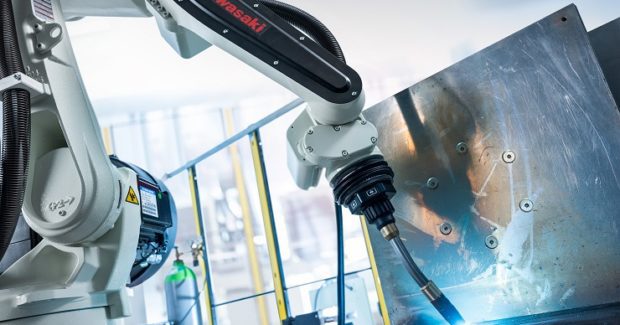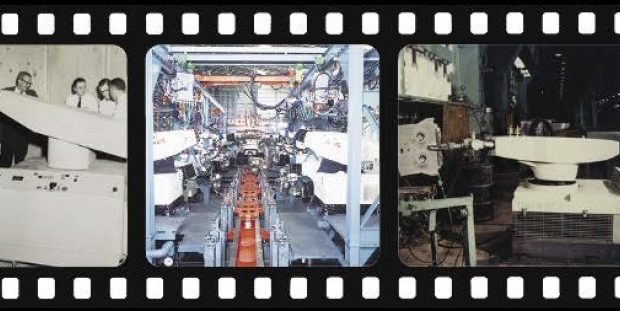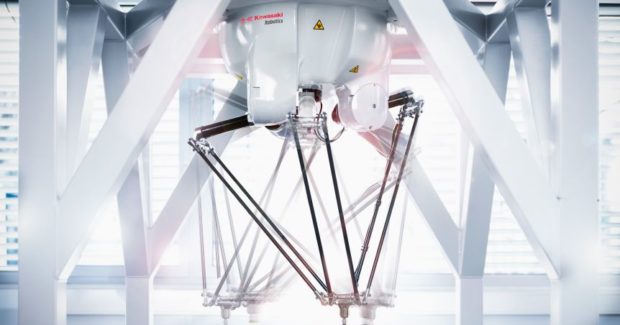How Automotive Robotics Paved the Way for Modern Automation
Demand for automation continues to escalate as companies search for ways to optimize operations — at this time only a small percentage of factory work is automated. Factory automation has come a long way — where to next?
Posted: October 24, 2021
COVER STORY
By Lilly Ristau
Like most heavy machinery, industrial robot arms have come a long way since their initial concepts. We are so used to seeing modern factory floors with sleek robot arms performing various tasks with ease that it’s hard to believe the first industrial robot arm, the Unimate, weighed 1.6 tons with only a 12 kg payload. The evolution of automation began roughly 70 years ago, but aspects of the Unimate, and its roots in the automotive industry, are still prevalent in today’s robotic arms.
THE BIRTH OF AUTOMATION
This story begins with Joseph Engelberger and G.C. Devol, Jr., who brought the Unimate from an idea to a fully realized product. Once General Motors saw a prototype in 1959, they decided to install the Unimate in their factories, which completely changed the automotive industry moving forward. After increasing the robot’s axes from five to six and doubling the payload, the Unimate became a global hit.
“It was the right application at the right time,” said Samir Patel, Kawasaki Robotics (USA), Inc.’s senior director of robotics engineering. “Technologies such as controls and hydraulics were getting developed so when the early ’60s hit, Devol and Engelberger got together and developed the hydraulic robot.”
Kawasaki Aircraft Industries saw the potential of automation and had a goal of developing industrial robots of their own in the future. In mid-century Japan, labor shortages and a growing demand in the automotive industry created a production gap that automation could fix. When Unimation sought a Japanese partner, Kawasaki fought hard to fill that spot — and they did. In 1968, they began manufacturing the Kawasaki-Unimate for the Japanese market, thus expanding the reach of robotics.
AUTOMOTIVE PROVING GROUNDS
The Unimate was initially installed on automotive lines to improve product quality and relieve line workers of cumbersome, dangerous spot welding tasks. One car required human workers to execute hundreds of exact spot welds using a heavy spot welding gun; an ergonomically challenging and dangerous task that is difficult to do with precision. For car manufacturers, robotic automation was a win-win.
“The mass production system used in the automobile industry in the 1960s allowed automotive manufacturers to efficiently produce quality cars at low cost,” said Kawasaki Robotics (USA), Inc.’s President Kazuhiro Saito. “Workers in the automotive industry were doing monotonous hard work, and automotive manufacturers were urgently required to free them from these types of tasks.”
After seeing the proven success of automation in the automotive industry, it wasn’t long before other industries wanted to see how robotics could improve their business models. Now, robots can be found in a multitude of manufacturing processes, ranging from delicate printed circuit board handling in the electronics industry to constructing prefabricated homes.
“Companies saw robots repeatedly doing the same task again and again and producing a quality product, which posed an opportunity to use it for any mass-produced product or application,” Patel said.
Across the years, crucial features of automotive robots have become the benchmark for robots used in any industry, such as high speeds, small footprints, and programming flexibility — but one of the most vital is reliability, Patel noted. Kawasaki’s robust experience in automotive has taught them that moments of unexpected downtime can negatively affect the bottom line, which is why they do extra testing to ensure their robots are real-world ready.
“Even a minute of stoppage on an automotive production line results in thousands of dollars in missed profit,” Patel said. “Kawasaki robots are thoroughly tested for thousands of cycles before releasing for sale to any customer.”
TECNOLOGY ADVANCES AUTOMATION
Major technological advances have allowed robots to become the sleek workhorses you see today. Continued improvement in electronics led to higher processing power, memory capacity and memory type. The improvement of FEA tools allowed for lighter mechanical arms to operate faster while carrying the same payloads, and the invention of AC Servo motors improved power density.
“The arms are getting slimmer and lighter, while the payload is higher…” Saito said. “The evolution of control software has made it possible to control slim and lightweight arms quickly and smoothly, which also helps to reduce the weight of robot arms. Robot controllers have also evolved and become smaller. Kawasaki’s latest F series controller is about the size of a shoe box.”
While technology has come leaps and bounds since the 1960s, basic elements of the robot arm have stayed the same — and likely always will.
“Formulas and derivations of kinematics were well developed a long time back,” Patel said. “They were used in early days and are still being used for modern industrial robots. Of course, with the advent of more computing power, there are improved algorithms that take into account dynamics of the arm for improved robot path planning and performance.”
LOOKING FORWARD
There is no doubt that industrial automation as we know it today has evolved dramatically since the first Unimate was introduced to automotive lines. Advances in technology, programming and mechanics have made robots highly efficient machines that can streamline operations in any industry — not just automotive. So what’s next?
In today’s U.S. market, the supply chain industry appears to be in a similar position as Japan’s automotive market was in the 1960s, Patel said. Significant growth, high demand, and labor shortages in the wake of the COVID-19 pandemic make automation a logical next step for these types of businesses. On top of that, advances in AI and machine learning make it possible to execute complex warehousing applications such as mixed-pack palletizing, SKU sorting and kitting.
We can look forward to a future with more robots in more industries, relieving more employees of dull, dirty and dangerous tasks.
“Demand for automation will continue to increase in the future,” Saito said. “Despite the increasing application of automated equipment and industrial robots in the industry, only a small percentage of all work is automated. As long as there are companies who want to optimize operations and relieve employees of monotonous work, automation will continue to increase. Robots are continuously evolving, their application range is expanding, and we are now able to meet the expectations of many industries.”
Lilly Ristau is the senior content marketing specialist for Kawasaki Robotics (USA), Inc. Email Lilly.Ristau@kri-us.com.














